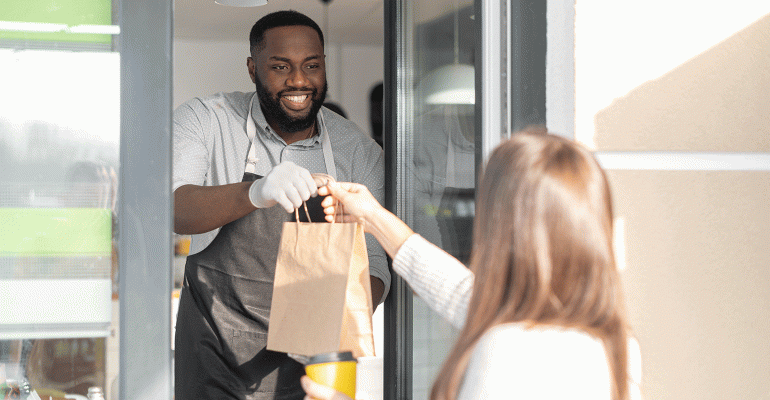Restaurant operators are adding sales channels that give them additional revenue streams as well as the chance to acquire new and different types of patrons. Whether through catering, retail, wholesale, or subscriptions/membership clubs, restaurants are reaching customers in more ways than ever before.
The shift toward multichannel means restaurants need technology not only in the front of the house, but also in the back. Invoicing features and other record-keeping tools have never been more important for the everyday operations of restaurant brands — whether they have one location or dozens. Due to the extra complexities that come with multichannel operations, restaurants need a streamlined system for customer invoices, collecting payments, prepping, and fulfilling orders.
If that sounds like a lot of paperwork, it doesn’t have to be. Here are four emerging revenue streams for restaurants, why they are important, and how operators can manage them.
Adding walk-away retail
The line between dining and food shopping has been blurred. In New York, foodie favorites like Sahadi’s, Eataly, and Court Street Grocers have bolstered this trend, offering great dishes, on-the-go bites, and hard-to-find items such as regional/international condiments and snacks. And it’s become a phenomenon from coast to coast. For instance, there’s Detroit-based bistro Eatori Market, Omaha’s French restaurant, La Buvette Wine & Grocery, and an Italian eatery called Flour + Water in San Francisco.
If you are a restaurant operator, it should no longer be “novel” to let people buy unprepared food from your stores and take it home. It’s become an important, additional revenue stream and can be part of almost any restaurant experience. Why not become diners’ go-to source for a bottle of wine on Wednesday in addition to their favorite Friday night dinner spot? Restaurants have an opportunity to create a new relationship with their patrons.
Appearing via freezer aisles, store shelves and online
One long-term strategic decision restaurants have recently faced is whether to enter into wholesale. Amazon, Walmart, and GoldBelly allow restaurants with popular, packageable menu items to box them up and ship them via their e-commerce platforms.
Yet, they can also wholesale through grocery chains. In 2015, New York-based Table 87 Coal Oven Pizza got $250,000 from investors on the popular NBC TV program Shark Tank to freeze-dry and package single slices and full pizzas. Since then, the company’s pizza has gotten freezer space in Walmart, Wegmans, and Whole Foods stores across the country, finding new kinds of customers that would have otherwise likely never heard of Table 87. Chicago-based sandwich chain Potbelly is another example, selling jars of its hot peppers regularly after people search offline and online for its critically renowned giardiniera.
Wholesaling is a revenue stream restaurants need to consider because it increases sales and, with the in-store exposure, bolsters their brand. And all of that is especially true if they have the backend technology to make channel expansions manageable. Harris’ Restaurant, a fine-dining steakhouse in San Francisco, recently expanded into mobile ordering and learned that having the right backend technology generates greater ROI, smoother operations and a happier staff.
Harnessing the catering opportunity
Restaurants offering catering isn’t a brand-new idea, but it’s been picking up steam in the last few years. First, the pandemic led many eateries to dip their toes into the catering waters by offering family meal packages. And now employers are providing free, catered lunches to get people back in the office, and it’s working: A recent survey found that 93% of company leaders said that more employees show up to the office on days when free food is offered.
The opportunity is even more formidable when considering that caterers are routinely hired by educational institutions, hospitals, and events organizers. All of those factors explain why brands such as Olive Garden, Chuy’s, and Red Robin have increased their focus on catering.
At the same time, adding catering to an operation means another layer of bookkeeping. This reality calls for cloud-based software that can help them manage invoices and handle other channels on the backend.
Offering meal subscriptions
Meal or product subscription packages are increasingly effective ways for eateries to add a revenue channel, whether they are four-star restaurants, fast-casual brands, or local bakeries. With grocery prices up recently due to inflation, the time is ripe for these kinds of services because they offer more cuisine options as well as convenience. Notable brands such as Taco Bell, Panera, and Sweetgreen have jumped into meal subscriptions this year.
More restaurants can do the same. Though platforms offer ways for independent restaurants to get plugged into city-specific subscription packages, those opportunities are limited. Restaurant operators should develop one-on-one relationships with customers by creating their own subscription plans and, therefore, keeping their first-party data. Such data can help them personalize offers in the long run as they learn more and more about each customer’s meal preferences.
Indeed, the restaurant sector is becoming more and more data-driven. The upshot is that digital tools can help operators take advantage of the emerging multichannel channels listed above by allowing them to take care of tasks such as customer invoicing, collecting payments, and prepping/fulfilling orders without taking up the whole day.
In the end, it’s all about acquiring new patrons and different types of customers while building on existing relationships with longtime diners. And the additional revenue streams will not only lift the bottom line but also allow for greater investment in people, technology, and other resources you’ll need to continue to grow.  AUTHOR BIO
AUTHOR BIO
Aman Narang is President, COO and co-founder of Toast, Inc., where he leads business development and innovation opportunities for the company. With decades of experience in the technology sector and leading complex business strategies, Aman has a unique perspective on how technology has grown and shaped the restaurant industry. Prior to founding Toast, Aman worked in a variety of positions at Endeca (now known as Oracle) where he spearheaded development efforts for the business intelligence platform and co-led the creation of Endeca’s mobile commerce business.

